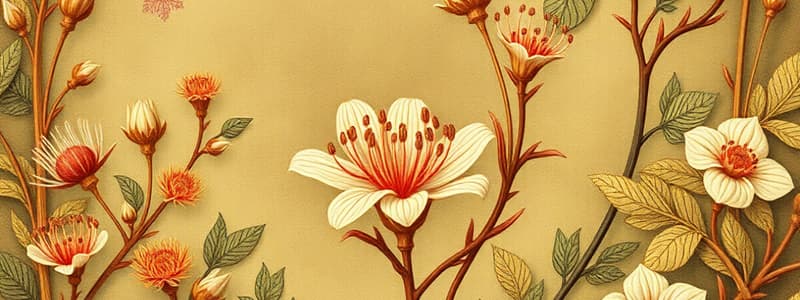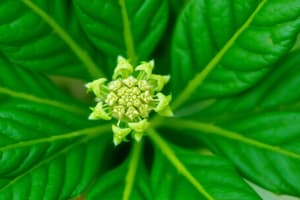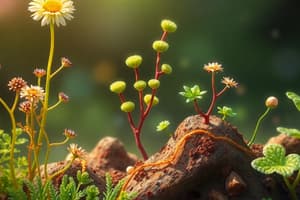Podcast
Questions and Answers
Which adaptation is required for plants to transition from non-vascular to vascular?
Which adaptation is required for plants to transition from non-vascular to vascular?
- Development of cuticles and stomata only.
- Development of pores for gas exchange.
- Development of cuticles, pores/stomata, and vascular tissues. (correct)
- Development of vascular tissues (xylem and phloem) only.
What is the role of xylem in vascular plants?
What is the role of xylem in vascular plants?
- To transport water in multiple directions using ATP.
- To transport water and nutrients in one direction.
- To transport water in one direction, utilizing the cohesion-tension mechanism. (correct)
- To transport sugar and nutrients in multiple directions.
How does water move from an area of high concentration in the soil to an area of low concentration inside a plant's root cells?
How does water move from an area of high concentration in the soil to an area of low concentration inside a plant's root cells?
- Transpiration
- Osmosis (correct)
- Active transport
- Cohesion-tension mechanism
What is the primary function of phloem?
What is the primary function of phloem?
How does water move into the phloem?
How does water move into the phloem?
What happens to sugar at the sink (roots/flowers)?
What happens to sugar at the sink (roots/flowers)?
What is a sporophyte?
What is a sporophyte?
What is the role of lignin in xylem cells?
What is the role of lignin in xylem cells?
What is the main characteristic of vessel elements that facilitates water movement?
What is the main characteristic of vessel elements that facilitates water movement?
How do tracheids facilitate water movement between cells?
How do tracheids facilitate water movement between cells?
In what period did club mosses first appear?
In what period did club mosses first appear?
What is unique about the spores of club mosses?
What is unique about the spores of club mosses?
What do ferns rely on for nutrition when they are young?
What do ferns rely on for nutrition when they are young?
Which feature is characteristic of Pteridophytes (ferns)?
Which feature is characteristic of Pteridophytes (ferns)?
What is the purpose of the cohesion-tension mechanism?
What is the purpose of the cohesion-tension mechanism?
How does the movement of water through xylem affect the pressure within phloem?
How does the movement of water through xylem affect the pressure within phloem?
Which of these traits do vascular plants exhibit?
Which of these traits do vascular plants exhibit?
How can the analysis of tree rings provide insights into past climate conditions?
How can the analysis of tree rings provide insights into past climate conditions?
What is the difference between earlywood and latewood in tree rings?
What is the difference between earlywood and latewood in tree rings?
Club mosses, spikemosses, and quillworts are classified into what group?
Club mosses, spikemosses, and quillworts are classified into what group?
In seedless vascular plants, the sporophyte generates via meiosis.
In seedless vascular plants, the sporophyte generates via meiosis.
Which plants have vessel elements?
Which plants have vessel elements?
Which plant adaptations help in the transition from water to land?
Which plant adaptations help in the transition from water to land?
What is homoplasy?
What is homoplasy?
What is the purpose of cohesion?
What is the purpose of cohesion?
What is the purpose of xylem cells?
What is the purpose of xylem cells?
What is a characteristic of a tree's heartwood?
What is a characteristic of a tree's heartwood?
Select the choice that displays the vascular plants.
Select the choice that displays the vascular plants.
During what eon did the first trace animals and algae appear?
During what eon did the first trace animals and algae appear?
From where do source cells load sugar into pholem?
From where do source cells load sugar into pholem?
What is needed for sperm cells to swim to the egg?
What is needed for sperm cells to swim to the egg?
Which features helped ancient club mosses grow so tall?
Which features helped ancient club mosses grow so tall?
During the Carboniferous period, what was the dominant type of plant life in swampy environments?
During the Carboniferous period, what was the dominant type of plant life in swampy environments?
Which of these plants thrives in dry regions?
Which of these plants thrives in dry regions?
What is a key difference between modern club mosses and their ancient relatives?
What is a key difference between modern club mosses and their ancient relatives?
In ferns, what process occurs in the sori?
In ferns, what process occurs in the sori?
Which evolutionary innovation allowed vascular plants to grow taller than non-vascular plants?
Which evolutionary innovation allowed vascular plants to grow taller than non-vascular plants?
Flashcards
Vascular Plants
Vascular Plants
Also known as Tracheophytes; plants with xylem and phloem for transport of water and nutrients.
Xylem and Phloem
Xylem and Phloem
Tissues in plants that transport water and nutrients.
True Roots
True Roots
Provides support and absorbs water/nutrients in vascular plants.
Leaves
Leaves
Signup and view all the flashcards
Complex Sporophyte
Complex Sporophyte
Signup and view all the flashcards
Transition Adaptations
Transition Adaptations
Signup and view all the flashcards
Xylem
Xylem
Signup and view all the flashcards
Cohesion-Tension Mechanism
Cohesion-Tension Mechanism
Signup and view all the flashcards
Osmosis
Osmosis
Signup and view all the flashcards
Tracheids
Tracheids
Signup and view all the flashcards
Vessel Elements
Vessel Elements
Signup and view all the flashcards
Phloem
Phloem
Signup and view all the flashcards
Pressure Flow Process
Pressure Flow Process
Signup and view all the flashcards
Source Cells
Source Cells
Signup and view all the flashcards
Sink Cells
Sink Cells
Signup and view all the flashcards
Phloem Function
Phloem Function
Signup and view all the flashcards
Seedless vasular plants
Seedless vasular plants
Signup and view all the flashcards
Seedless plants examples
Seedless plants examples
Signup and view all the flashcards
Water for reproduction
Water for reproduction
Signup and view all the flashcards
Dominant Generation
Dominant Generation
Signup and view all the flashcards
Club Mosses
Club Mosses
Signup and view all the flashcards
Ancient Club mosses
Ancient Club mosses
Signup and view all the flashcards
Modern Club mosses
Modern Club mosses
Signup and view all the flashcards
Lycopodium Dust
Lycopodium Dust
Signup and view all the flashcards
Pteridophyta (fern)
Pteridophyta (fern)
Signup and view all the flashcards
Sori (singular-Sorus)
Sori (singular-Sorus)
Signup and view all the flashcards
Lycophytes
Lycophytes
Signup and view all the flashcards
Sporophyte Stage (Diploid - 2n)
Sporophyte Stage (Diploid - 2n)
Signup and view all the flashcards
Study Notes
Vascular Plants (Tracheophytes)
- Includes lycophytes, pteridophytes, and seed plants
Key Characteristics of Vascular Plants
- Water and nutrients are transported through xylem and phloem (vascular tissues)
- Roots provide transport and support
- Leaves increase surface area for photosynthesis and evolved twice
- Dominated by a larger, more complex sporophyte generation
Xylem and Phloem
- Tissues used to transport water and nutrients
- Xylem transports water in one direction, cells are dead
- Pholem transports sugar and other, more in two directions
- The cohesion-tension mechanism works by cohesion, where water molecules move from high to low concentration
Cohesion-Tension Theory
- Water travels from roots to evaporating surfaces through the continuous liquid columns that form
- Water evaporates, and evaporated water is replaced by water in the xylem
- Water is pulled out of root cells, and water is pulled out of the soil
Evolution of Vascular Tissue
- Vascular tissue evolved in gradual steps
- Plants gained increased structural support, which allowed them to grow upright
Types of Xylem Cells
- Two cell walls exist in tracheids
- Primary cell wall is made of cellulose and is flexible
- Secondary cell wall is made of lignin, a tough, woody substance; it helps plants stay upright
- Vessel elements exist in angiosperms, gnetophytes, and ferns
- Vessel elements are shorter and wider than tracheids, with water flowing faster through them
- They contain large openings called perforation plates
- These structures evolved independently in different plant groups (convergent evolution/homoplasy)
Translocation
- "Source cells" load sugar into phloem via active transport
- Water moves into phloem via osmosis
- Pressure increases inside phloem
- "Sap" flows along phloem down a pressure gradient
- "Sink" cells near phloem remove sugars via active transport, water leaving phloem
- Sap flow direction is dependent on time of year
Phloem
- Vascular plant tissue transports sugar and nutrients in both directions
- It is also dependent on where it is needed, and requires ATP
- Sugars made/stored in source cells (leaves during photosynthesis)
- Sugars taken/stored in sink cells (roots, flowers)
- Sugars load into phloem cells at the source with ATP, water from the xylem enters the pholem
- Incoming water causes a pressure build which pushes sugary sap
- In spring/summer, source cells produce sugar and send to sink
- In winter, store carbohydrates that are found in roots and also become the source
Tree Rings
- Tree ring dating allows us to check the support to the tree, and see active transport of water and nutrients
- Latewood is formed in late summer/fall with smaller, dense, darker cells due to less water
- Earlywood is formed in spring with larger, lighter cells
Seedless Vascular Plants
- Have vascular tissue, however, do not make seeds
- They include ferns, horsetails and club mossses
- they are dependent on water for reproduction,
- the sporophyte is the dominant generation
- The sporophyte developed from a spore is diploid(2n) and develops into a gametophyte
- First showed up in the Devonian period and Carboniferous period
Club Mosses (Lycophytes)
- Are distinct from mosses
- Ancient club mosses
- Massive (100ft tall, 3 ft wide)
- Dominated the Carboniferous period
- Modern club mosses vs modern mosses
- Are tiny: knee height or below
- Are like ground covers
- Have true roots, stems, leaves, and vascular tissue
- Ancient swampy environments allowed them to compress into coal deposits
- Spores are used for reproduction and are flammable, made of oils
- Are among the earliest vascular plants, from around 400-300 million years ago
Carboniferous Period
- Time of vast swampy forests full of primitive plants; became today's coal deposits
- Lycophytes/club mosses could grow upto 100 feet tall and 3 feet wide
- The upper-canopy trees include the extinct tree lycopsid sigillaria, the cordaites, the Marattialean tree ferns, and the noeggerathiales
Pteridophyta (Ferns)
- Produce large and well-developed leaves (fronds), including invasive plants
- They germinate on sorus
- They are highly variable, and can live in dry regions
- Ferns are the only seedless vascular plants that have large, well-developed leaves
- Produce spores that use meiosis in sori
- A new genus of ferns (19 species) are named Gaga due to resemblances
- They do not produce seeds and use spores to develop fronds
- Ferns are grouped in two life stages: sporophyte and gametophyte
- Sporophyte stage is diploid, produces spores with two sets of chromosomes through meiosis in structures called sori
- Gametophyte stage is haploid
Studying That Suits You
Use AI to generate personalized quizzes and flashcards to suit your learning preferences.





